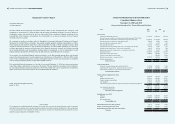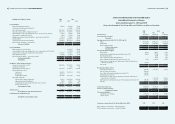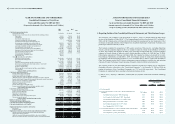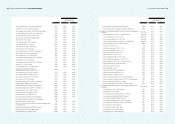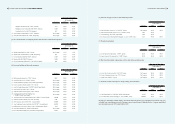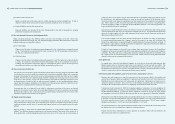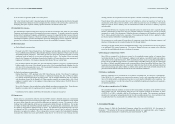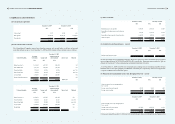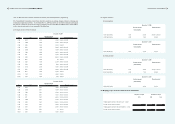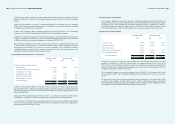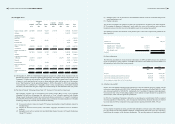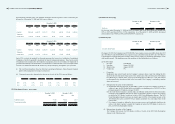Acer 2010 Annual Report Download - page 47
Download and view the complete annual report
Please find page 47 of the 2010 Acer annual report below. You can navigate through the pages in the report by either clicking on the pages listed below, or by using the keyword search tool below to find specific information within the annual report.
ACER INCORPORATED
2010 ANNUAL REPORT
90
FINANCIAL STANDING
91
in the fair value recognized in prot or loss of the period.
Fair value of share-based award is measured using the Black-Scholes option-pricing model or the binomial
option pricing-model, taking into account management’s best estimate of the exercise price, expected term,
underlying share price, expected volatility, expected dividends, and risk-free interest rate.
(22) Administrative expenses
The administrative expenses include direct expenses incurred for the business unit within the Consolidated
Companies and expenses incurred for managing the investee companies. To properly present the operating
income of the Consolidated Companies, administrative expenses are categorized as direct expenses incurred
for the Consolidated Companies, which are included as administrative expenses in the accompanying
consolidated statements of income and expenses incurred for managing the investee companies, which are
presented as a reduction of net investment income (loss) in the consolidated statements of income.
(23) Retirement plans
(a) Dened benet retirement plans
Pursuant to the ROC Labor Standards Law, the Company and subsidiaries located in the Republic of
China established noncontributory dened benet employee retirement plans (the “Plans”) and retirement
fund administration committees. These Plans provide for lump-sum retirement benefits to retiring
employees based on length of service, age, and certain other factors. The funding of these retirement
plans by the Company and subsidiaries located in the Republic of China is based on certain percentage of
employees’ total salaries. The funds are deposited with Bank of Taiwan or other banks.
For the defined benefit retirement plan, the Consolidated Companies recognize a minimum pension
liability equal to the excess of the actuarial present value of the accumulated benet obligation over the
fair value of the retirement plan’s assets. The Consolidated Companies also recognize the net periodic
pension cost based on an actuarial calculation.
(b) Dened contribution retirement plans
Starting from July 1, 2005, pursuant to the ROC Labor Pension Act (the “New System”), employees
who elected to participate in the New System or commenced working after July 1, 2005, are subject
to a dened contribution plan under the New System. For the dened contribution plan, the Company
and subsidiaries located in the Republic of China contribute monthly an amount equal to 6% of each
employee’s monthly salary to the employee’s individual pension fund account at the ROC Bureau of
Labor Insurance.
Most of the Company’s foreign subsidiaries adopt dened contribution retirement plans. These plans are
funded in accordance with the regulations of their respective country of establishment.
Contributions for the dened contribution retirement plans are expensed as incurred.
(24) Income taxes
Income taxes are accounted for under the asset and liability method. Deferred income tax is determined
based on differences between the nancial statements and tax basis of assets and liabilities using enacted
tax rates in effect during the years in which the differences are expected to reverse. The income tax effects
resulting from taxable temporary differences are recognized as deferred income tax liabilities. The income
tax effects resulting from deductible temporary differences, net operating loss carryforwards, and income
tax credits are recognized as deferred income tax assets. The realization of the deferred income tax assets
is evaluated, and if it is considered more likely than not that the asset will not be realized, a valuation
allowance is recognized accordingly. When a change in the tax rate is enacted, the Consolidated Companies
recalculate the deferred tax assets and liabilities using the new tax rate in the year of change and any
resulting variances are recognized as income tax expense or benet of continuing operations accordingly.
Classification of the deferred income tax assets or liabilities as current or noncurrent is based on the
classification of the related asset or liability. If the deferred income tax asset or liability is not directly
related to a specic asset or liability, then the classication is based on the asset’s or liability’s expected
realization date.
If a valuation allowance is recognized at the acquisition date for deferred tax assets acquired through
business combination accounted for using the purchase method of accounting, the income tax benefit
recognized as a result of the elimination of valuation allowance subsequent to the acquisition is to be applied
rst to reduce goodwill related to the acquisition. The remaining tax benet, if any, is applied to reduce
income tax expense attributable to continuing operations.
The investment tax credits granted for purchases of equipment, research and development expenses, and
employee training expenses are recognized using the ow-through method.
According to the ROC Income Tax Act, undistributed earnings, if any, earned after June 30, 1997, are subject
to an additional 10% retained earnings tax. The surtax is charged to income tax expense in the following
year when the stockholders decide not to distribute the earnings.
(25) Earnings per common share (“EPS”)
Basic EPS are computed by dividing net income by the weighted-average number of common shares
outstanding during the year. The Company’s employee stock options, convertible bonds and employee
stock bonuses to be issued after January 1, 2010 are potential common stock. In computing diluted EPS, net
income and the weighted-average number of common shares outstanding during the year are adjusted for
the effects of dilutive potential common stock, assuming dilutive shares equivalents had been issued. The
weighted-average outstanding shares are retroactively adjusted for the effects of stock dividends transferred
from retained earnings and capital surplus to common stock and for those stock dividends issued for the
period between the balance sheet date and the release date of nancial statements.
(26) Business combination
Business combinations are accounted for in accordance with SFAS No. 25 “Business Combinations”.
Under SFAS No. 25, acquisition costs represent the amount of cash or cash equivalents paid and the fair
value of the other purchase consideration given, plus any costs directly attributable to the acquisition. The
excess of acquisition cost over the fair value of the net identiable tangible and intangible assets acquired is
recognized as goodwill.
(27) Convenience translation into U.S. dollars
The consolidated nancial statements are stated in New Taiwan dollars. Translation of the 2010 New Taiwan
dollar amounts into U.S. dollar amounts, using the spot rate of Bank of Taiwan on December 31, 2010,
of NT$29.13 to US$1, is included solely for the convenience of the readers. The convenience translations
should not be construed as representations that the New Taiwan dollar amounts have been, could have been,
or could in the future be, converted into U.S. dollars at this or any other rate of exchange.
3. Accounting Changes
Effective January 1, 2009, the Consolidated Companies adopted the revised SFAS No. 10, “Accounting for
Inventories.” The adoption of this new accounting principle did not have signicant effect on the Company’s
consolidated nancial statements as of and for the year ended December 31, 2009.



